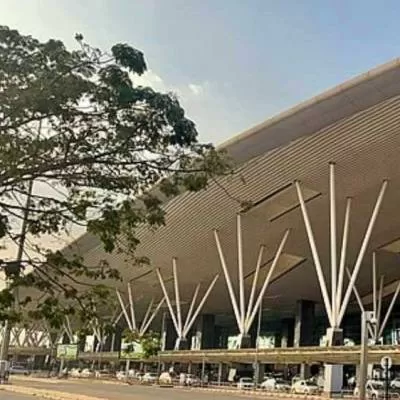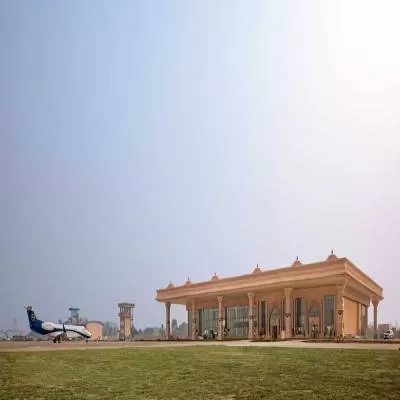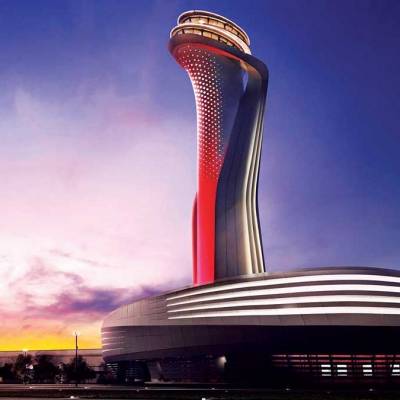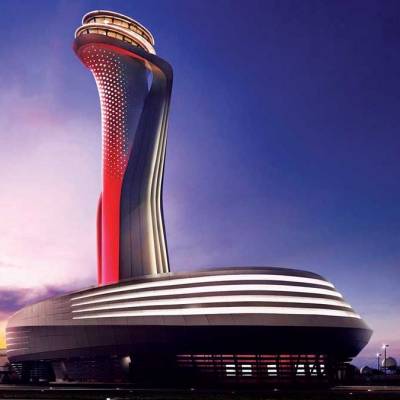- Home
- Infrastructure Transport
- AVIATION & AIRPORTS
- Airports Design And Build
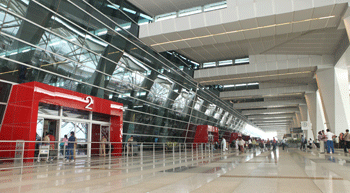
Airports Design And Build
Cancelled takeoffs, midair turbulence and interminable delays may be a thing of the past for Indian airport development. With the new Government clearing the runway for nationwide air connectivity, the focus is now on designing and building new airports for the next generation of travellers.
Today, India handles about 122 million domestic and about 47 million international passengers; the country is poised to handle 217 million domestic and 76 million international passengers by 2020. Amber Dubey, Partner & India Head of Aerospace and Defence, KPMG, says, ´Indian aviation is on a high growth path and is expected to be the third largest aviation market by 2020, behind the US and China.´ And Partha Ghosh, Managing Director, Bengal Aerotropolis Projects Ltd, adds, ´The size of the civil aviation industry in India is $16 billion and it is among the top 10 globally.´ He believes that the Indian aviation sector has the potential to attain the No. 1 position by 2030 and the Asia Pacific region will emerge as the largest aviation market by 2032.
The agenda
That´s the potential; now, for the process.
At present, there are around 450 used or unused and abandoned airports and airstrips across India. And several Tier-II or Tier-III cities are still unconnected or underserved. To enhance and broaden air connectivity, the Government plans to build nearly 200 low-cost airports in the next 20 years.
For starters, the Airports Authority of India (AAI) announced the development of 50 low-cost airports on a public-private partnership (PPP) model with the Centre, earmarking Rs 100 crore for each one (complete list on page 53). ´AAI is geared up to provide modern infrastructure at all airports,´ says Sudhir Raheja, Member-Planning & Chairman, AAI. ´And plans to operationalise or build 50 ´no-frills´ airports in Tier-II and Tier-III cities will provide seamless air connectivity across the country.´ (Read interview on page 52.)
´We believe the second phase of growth in Indian aviation is expected to come from Tier-II and Tier-III cities,´ echoes Ghosh. ´Non-metro airports presently account for about 30 per cent of the total air traffic, which is expected to rise to 45 per cent in the next few years, representing vast untapped future market potential.´ Dubey agrees, stating, ´The future of Indian aviation belongs to no-frills airports in India´s interiors.´
Apart from low-cost airports, opportunities abound with several Greenfield projects - Navi Mumbai, Mopa (Goa), Sindhudurg, Gulbarga, Hassan, Shimoga, Kannur, Itanagar, Kushinagar, Kohima - in various stages of conceptualisation, development and completion (see table on page 62) and many airports, including Chennai, Kolkata, Ahmedabad, Jaipur, Lucknow and Guwahati, being privatised.
All this spells boom time for stakeholders. Now, let´s see what goes into designing and building modern airports, whether they are high budget or no frills.
Design matters
In the past seven to eight years, India has seen major advancement in terminal design with greater complexity in architecture, engineering and planning to maximise the structure´s life and potential. Here are some factors to consider:
Duplication to expand:
´Repetition in design will help an airport easily expand in future,´ says Abhin Alimchandani, Proprietor, STUP Design Forum. Both Hyderabad and Bengaluru airports, with which he has been involved, have undergone expansion. Another example is Bikaner´s small scale terminal building made of prefab structure. RS Meena, Assistant General Manager-Civil, Airports Authority of India, and head of the airport, tells us, ´The aim was that if we make this a bigger airport in future, the same design can be easily replicated through PEB.´ He adds that using PEB reduced construction time and cost; the terminal was built in nine months with a total cost of Rs 15 crore.
Building materials: While India has favoured concrete so far, steel is a new material to consider. Gurpreet Singh Shah, Principal Architect & Urban Designer, Creative Group, who has worked on many airport development projects in India, including Chennai, Vadodara, Goa and Raipur, and the upgrade of the Delhi terminals, says, ´All terminals are now being built in steel as it is malleable; one can make ductile and organic three-dimensional shapes with it.´ Then, there´s glass. ´To maximise daylight and make the terminal transparent, energy-efficient neutral glass panels can act to minimise heat gain,´ he adds, also emphasising on the need to use recycled materials like fly-ash and AAC (autoclaved aerated concrete) blocks instead of bricks.
Roof design: An insulated roof can reduce heat gain. For this, Shah points to materials like Kalzip, a double seam roofing system, and skylights in the form of 16-mm multi-cellular polycarbonate sheets. ´With these, maximum sunlight is welcomed yet the building is protected from solar heat regressions.
´While Alimchandani seconds the use of Kalzip for airport roofing, he offers an alternative:
´The use of solar panels on roofing.´ For its part, Interarch executed the structural steel works and the entire roofing system for the outstanding Delhi International Airport Ltd (DIAL) Terminal 3. ´Interarch took over the responsibilities of the structural steel work and roofing from lead contractor L&T,´ reveals Gautam Suri, CTO & Founder Director, Interarch. ´The entire roof system comprised seven independent insulating layers, laid layer by layer, by hand, over a coverage area of over 45 acre. That was almost 315 acre of roofing laid in less than 12 months.´
Construction technologies: Sustainable design caters to active and passive strategies. ´While passive strategies (wall, glazing, building envelope) are observed at the time of construction, active strategies (electricals, fire alarm, controls) can be monitored during the course, which makes the building more environment-friendly and efficient,´ explains Shah. He recalls a technology introduced in India for the first time in Chennai airport: 500 mm diameter pipes to bend where the trusses and columns meet. ´So we don´t have columns or beams but one monolithic structure, thereby reducing the cost of steel for the structural members of the roof,´ he says. Also, new terminals should be fully integrated with building management systems (BMS) and IT to monitor systems like HVAC and lighting control to optimise services.
Technology, clearly, comes in various forms. ´Difficult topography and hostile weather conditions made Sikkim´s first greenfield project in Pakyong extremely challenging,´ says SK Goyal, Executive Vice President & COO-Buildings and Infrastructure, India, Punj Lloyd Group. To ensure minimal impact on the environment and rich ecological diversity, composite reinforced soil technology was used to retain the high embankments by reinforced soil walls. ´While the primary reinforcement comprised high-strength flexible geogrids made of polyester fibres and protected with high-quality LDPE coating, the secondary reinforcement was provided by heavily galvanised, PVC-coated mechanically woven steel mesh panels,´ shares Goyal. ´A total of 1,514-m-long RE walls with height varying from 32 m to 80.38 m were built for the project. A slope of 650 was maintained by using welded wire mesh steel rods. Biodegradable coir mats were provided at the fascia to facilitate growth of vegetation. In places where space was a constraint, gabions filled with boulders were provided to act as fascia for protecting the reinforced soil.´ When completed, the highest reinforcement wall will stand at 80.38 m, one of the tallest reinforcement walls in the world.
Passenger comfort: This is one factor that separates the best airports world over from the also-rans. Alimchandani believes that the passenger should enjoy the airport experience to the hilt without experience fatigue or ennui. ´Escalators need to be planned to ensure that passengers move from one place to another without feeling tired,´ he affirms.
Thus, a judicious mixture of technologies, materials and attention to detail is essential to ensure that a terminal has a life of 50-60 years.
What´s new?
Enabling the process is a profusion of products and services. For instance, the offerings of UTC Building & Industrial Systems (BIS) for airport infrastructure include Carrier Evergreen 19XRD centrifugal chillers and 747 Internet protocol (IP) cameras. Amit Maheshwari, Director-Marketing & Strategy, Climate, Controls & Security India, UTC, says, ´These chillers have a dual-compressor centrifugal chiller that represents cutting-edge heating, ventilation and air-conditioning technology and is ideal for large airports.´ In addition, UTC BIS offers security solutions through its brands Edwards and Kidde; the latter brand also offers fire suppression and safety systems. ´The EST3-Sixty from Edwards, which unites a robust, field-proven communications backbone with mass notification technology, provides a threat detection and crisis management solution for airports of any size,´ he adds.
Another intelligent offering for airports is Autodesk´s Building Information Modelling (BIM) solution. ´Airports have two aspects of operations: field-side and integrated transport, and the terminal building,´ elaborates Anand Sirohi, Head-Engineering, Natural Resources & Infrastructure (ENI), Autodesk India & SAARC. ´The Autodesk Infrastructure Design Suite is a solution for both requirements.´ BIM for airports is about creating and using a 3D, intelligent model for planning, designing, building and managing infrastructure. It provides greater insight for every phase of an airport project - to plan, design, build and manage more efficiently, economically, and with less environmental impact.
Evidently, intelligence is now an imperative in airport design. After delivering one of the largest integrated BMS and HVAC central management systems for Delhi´s Terminal 3, Honeywell Building Solutions has designed another record-breaking Integrated Building Management Solution (IBMS) for Kolkata´s Netaji Subhas Chandra Bose International Airport. ´IBMS monitors and controls various parameters of HVAC, electrical, plumbing and fire-fighting systems throughout the new terminal from a single workstation,´ says Priyanshu Singh, Regional General Manager, Honeywell Building Solutions, India. ´It has the intelligence to monitor and control climatic conditions, CO2 and humidity levels throughout the terminal.´ Equally essential is mobility. ´Whether you are looking for wide door elevators for passenger and baggage mobility or considering walking lengths up to 150 m, Schindler has the most comprehensive portfolio of escalators, elevators and moving walks for airport transportation like the Schindler 9300AE, 9500, 5400AP,´ says Antony Parokaran, CEO, Schindler India Pvt Ltd. At any airport, a large number of people or passengers must reach their destinations quickly and efficiently. This requires synchronised traffic patterns, monitoring and focus on safety with strict adherence to Indian and European safety standards. Hence, Schindler´s devised BMS helps monitor all equipment through a server room, which is panelled for fire alarms and connected to CCTVs in elevators. The most recent being the Mumbai International Airport where Schindler would be supplying 132 units consisting of 62 elevators, 44 escalators and 26 moving walks out of which 117 are already installed and running.
Indeed, innovation and improvement have percolated to every aspect of airport design today - even hangar doors. These are safer and more reliable, suitable for extreme climates and wind conditions. ´Our doors are manufactured with high-quality mechanical and electrical equipment,´ says Samir Gandhi, Managing Director, Gandhi Automations. ´We can offer hangar doors where no headroom is available and side clearances are permitted or at sites that do not have space on the side for the door to slide. In the former case, we can offer a sliding door; for the latter, a fabric hoist-up door.´
Different strokes
So, with no-frills airports being the order of the day, what are the necessary modifications in terms of construction and specifications as compared to big-ticket airports?
´One important angle is design,´ says Shah. In a mega, high-budget project, one can design structures that are more serene and dreamlike. However, in a low-cost airport, where the volumetric composition and planning needs to be carefully crafted, the space has to be optimised and the structure and architecture complexities have to be kept to the minimum to enable speedy construction at a lower cost. ´One way of cost-cutting is specifications, and the other way is to reduce the built-up area through efficient planning, which develops a modular terminal, generated effortlessly and eases the contractor on labour cost.´ And Dubey reasons, ´Other than a runway and a prefabricated terminal with clean toilets, one does not need much.´
But it´s a little more complicated in Alimchandani´s view. He calls for a more detailed understanding of how these low-cost airports are envisaged to determine their viability. Believing that a conventional, well-designed airport can also come close to a budget airport, he says, ´The low cost of a no-frills airport needs to be defined in the Indian context.´ Shah, too, has a point to make here. ´If we are diving towards low-cost airports, one needs to be sensitive towards optimising the cost. One should not be in a hurry to downgrade these airports to an extent that they don´t work in future.´
What kind of costs, then, are we actually looking at? ´L&T and other large contractors are developing new world-class terminals in India at anywhere from $2,500 to $3,000 per sq m,´ estimates Krishna Murthy, Senior Manager, Asia Lead for Global Aviation, Louis Berger. ´Considering that low-cost airport terminals will have no frills with a focus on passenger processing, they will be developed at close to $1,000 per sq m.´ To this, Dubey adds, ´The cost should not exceed Rs 45-50 crore per no-frills airport. Once traffic picks up from, say, two flights a day to 20, the terminal and other facilities can be scaled up in a modular fashion.´
Dubey also recommends a ´railway station plus´ model for such airports, without compromising on safety and security. ´They should avoid costly air-conditioning, baggage carousels, X-ray machines and arrival lounges,´ he goes on. ´Safety and security can be handled by local police and fire brigade for just 60 minutes prior and after the aircraft arrives and departs. The focus should shift from security of the ´airport´ to security of the ´aircraft´. The approach has to change from ´visible´ security to ´smart´ security using CCTV and a small, quick-reaction security team. There is no need for costly air navigation equipment; it can be provided remotely by larger airports.´ And Murthy tells us, ´Low-cost airports are planned to be super sheds offering basic passenger processing capabilities with minimalistic architectural significance. To keep costs low, airport terminal design will be replicated and construction streamlined for low-cost delivery. The opportunities are primarily for local contractors or suppliers.´
Finding funds
Whatever the size, given the risks, lenders are cautious when issuing long-term debt to airport operators. Financial support, especially for developers and airlines serving Tier-II and Tier-III cities, is critical. Hence, there is a need to evolve innovative funding solutions. ´PPP players have access to cheap capital from sovereign wealth funds, pension funds or East Asian project finance sources,´ says Murthy. ´In large airports, at least 60-70 per cent is expected to come from private players.´ In the interim, Dubey offers some ideas:
Allowing airport companies to issue tax-free infrastructure bonds.
Ensuring greater External Commercial Borrowings (ECBs) for the sector by specifying separate sectoral limit.
Facilitating Airport Development Fee (ADF) for pre-funding of airports. This reduces the returns that need to be provided to airport developers and helps keep tariffs down.
Creating an Essential Air Services Fund (EASF) to support air access to Tier-II and Tier-III cities. This could be on similar lines as the Airport Improvement Program (AIP) in the US or the India Infrastructure Project Development Fund (IIPDF) used to support other infrastructure sectors in India.
The tendering process
Tendering is an important step for the fruition of any infrastructure project. ´A tender document is like a bible and, in India, the item rate contract is a common approach,´says Tulsidas Naik, Regional Head (West Zone), Currie & Brown (India) Pvt Ltd, a company that focuses on cost management for airport projects. He explains that the tendering document is prepared in the presence of the consultant and architect and then floated to a couple of contractors for RFQ (request for quotation). Quotations are negotiated with each contracting company.
´In addition, we check the contractor´s bank balance over the past five years, completed projects, quality of work delivered and past experience in airport projects. Based on this, the client awards the contract to a turnkey contractor with the lowest quotation. Once the contractor comes on board, he is responsible to appoint all the subcontractors for mechanical, electrical, HVAC, plumbing and fire-fighting works.´ Of the two models available for airport projects - EPC, where the contractor designs, procures and builds the project, and PPP - Goyal picks his preference. ´The EPC model is recommended as it reduces stress on the owner,´ he says. ´There is a single point of contact for the owner.´
Obstacle course
Whatever the size, scale or nature of any project, getting an airport off the ground is no cakewalk. Ask Sanjay Bhatia, Managing Director, CIDCO, a relieved man now that the much awaited Navi Mumbai Airport, slated to be among India´s largest Greenfield airports, has finally received all clearances. ´We have invited the RFQ and the last date is 30 October, 2014,´ he shares. ´This will be followed by a qualification process and companies will be selected to prepare the RFP (request for proposal).´ He anticipates that there will be a contractor in place by April-May 2015.
Land acquisition posed a major hurdle for this project. ´With 600 hectare in private hands, project-affected people have now agreed to sign consent awards and have started handing over the land to us,´ says Bhatia. He offers a tried-and-tested solution to the problem: ´We have developed a new model where one can become partners with us by taking 22.5 per cent developed land from us.´ However, he clarifies that this can only be done by a new town development authority.
´We should establish an Inter-Ministerial Group for Aviation (IMGA) to take up aviation reforms that have inter-ministry overlaps, especially on issues related to land acquisition and regulatory clearances,´ says Dubey. ´The abolition of the Planning Commission may help as, at times, it created more roadblocks than solutions.ö Meanwhile, to ensure timely execution, a spokesperson of Mumbai International Airport Ltd calls for the government´s lead in expediting clearance processes. Also, Murthy recommends the appointment of a ´chief coordinator´ at the ministry level reaching out across various departments for timely project clearance.
Smooth landing
All considered, one needs a stable, transparent, predictable and investor-friendly regulatory regime with a mechanism for time-bound resolution of issues to attract the necessary investment to the aviation sector. ´Access to aviation is still a dream for nearly 99 per cent of the population, nearly 30 per cent of which is the upwardly mobile middle class,´ avers Dubey. ´This is a large, untapped potential for growth and it is critical for industry stakeholders to engage with the Ministry of Civil Aviation and bring in long pending reforms.´
On the design front, sustainability will be the key moving forward into an energy-scarce future. In this context, Shah advocates the adoption of passive energy strategies, affirming that a building´s envelope must be sustainable. And on an aesthetic note, Alimchandani lays emphasis on the need for airport design to reflect local flavour. ´An airport is the first step when anyone walks into a city or town,´ he reasons. ´Hence, the next-generation airports should relate more to the local context, with the use of local materials and symbols to actually showcase the culture of the place.´
Whatever the location, though, the building blocks to success remain constant, as SM Shetty, COO, Currie & Brown (India) Pvt Ltd, tells us.´Time, quality and cost are critical to any project,´ he insists. The keys to a successful - and smooth - landing!
´The civil aviation scenario is quite upbeat,´ confirms Sudhir Raheja, Member-Planning & Chairman, Airports Authority of India (AAI). After witnessing a downslide in 2012-13, air traffic has shown an upward movement in the past financial year, registering 6 per cent growth. With AAI´s recent announcement to develop 50 low-cost airports, Raheja shares more insight on the sector with SHRIYAL SETHUMADHAVAN.
How do you view the current scenario for airport development in India?
As of now, there are world-class airports in all metros, such as Delhi, Mumbai, Chennai, Kolkata, Bengaluru and Hyderabad. There is a top-down approach. Earlier, we looked at the state of Indian airports and tried to improve on that, now we look at the best airports in the world and try to emulate them in the Indian context. AAI has also completed the modernisation of 60 non-metro airports and is now focusing on remote areas and Tier-II and Tier-III cities with business and tourism potential for operation of small regional airlines. These airports will be developed on a no-frills model. Hence, cost of construction, operation and maintenance is minimal and services are provided at competitive rates. Eventually, these will become self-sustaining and can be developed into full service airports when the demand increases. This will also ensure equitable and inclusive growth of the sector. Indeed, the next boom in the aviation sector is expected from no-frills airports.
Tell us more about the plan to develop 50 low-cost airports.
The plan to construct or operationalise 50 no-frills airports is AAI´s attempt to align with the vision of the Government to provide air connectivity to every nook and corner of the country (List of 50 low-cost airports indicated on the following page). The cities are identified based on population, economic growth and tourism potential. In addition to airport operators, state governments, tourism industry and airlines are the major stakeholders. Development of no-frill airports means that the airport operator will be less burdened with construction and operation costs and can achieve better growth faster. Also over time, these airports can emerge as normal airports and become commercially viable. As these airports are planned as small airports, the aircrafts required will be small aircrafts, which are cheaper to own and operate. This offers an opportunity for small and regional operators to flourish. Bigger operators also stand to gain by code sharing with regional airlines to fulfil their route commitments, if the policy stipulates. The emergence of regional airlines with small aircrafts can open the doors to the aircraft manufacturing industry and MRO services in India, which can bring in employment opportunities.
With the development of no-frill airports, tour operators can offer services at hitherto untapped but promising locations, thereby generating income and employment for local people. State governments also stand to gain as regional economic activities will get a spurt with the emergence of an airport. The most important stakeholders are the travelling public; with these airports, they will get fast and reliable connectivity at affordable prices.
While low-cost airports are said to be executed in a PPP model with the Centre earmarking Rs 100 crore for each airport, how much will a private player have to invest? Also, how will these airports be maintained and managed?
At present, the planning and financing models of no-frills airports along with regional and remote area connectivity are at the discussion stage with various stakeholders. In 2014-15, AAI will take up the construction of five no-frills airports. With respect to grant-in-aid from the Centre and development of other airports, decisions are yet to be firmed up. At present, AAI is spending from its internal resources.
Further, what are the new airport development opportunities in Greenfield airports and airports privatisation?
The policy of airport development, particularly Greenfield airports, is very supportive on private participation. To date, the Government has given the clearance for 15 Greenfield airports (see list on page 53); of these, except for the Pakyong project in Sikkim, all the others are being constructed or developed by the concerned state governments through private participation.
AAI is mostly concentrating on air connectivity in remote areas where socioeconomic and strategic considerations are more important than just commercial ones.
As reported, private operator contracts are to be awarded for six airports: Chennai, Kolkata, Lucknow, Guwahati, Jaipur and Ahmedabad. By when will these be awarded and based on what rate and criteria?
The operation, management and development of these six selected airports under the PPP model are in process. The RFQ (Request for Qualification) for prequalification of bidders has been issued. The structure of the concessionaire agreement (CA) is being deliberated between various related government departments. Once the CA is finalised, it may take around four to six months to complete the process.
What are the different tendering models adopted for airport projects? Considering the number of upcoming projects, please highlight the opportunities for vendors and suppliers.
AAI follows the open tender system through e-tendering for procurement. For specialised works, limited tender has also been adopted. However, in highly specialised works and procurements like radars or safety and security equipment, international or global tenders are preferred. Based on the guidelines of Central Vigilance Commission (CVC), the policy on e-tendering has been made and the same is being followed. Except for big contracts, a single-stage tendering system is normally followed. For big contracts there are two stages: RFP and RFQ.
Airport infrastructure is increasingly oriented towards modern technology to build smart airports that ensure free flow for passengers and freight, safe operations, and environment-friendly surroundings. Speedy construction and flexibility are the other parameters. Accordingly, products or systems that offer these will find place in the infrastructure development of airports.
What are the challenges faced in the development of Greenfield airports, or to be faced for low-cost airports?
At the clearance level, please share with us the bottlenecks and your recommendations to overcome them.
The construction of Greenfield airports depends on many factors such as site clearance, clearance from regulatory authorities or defence, other mandatory clearances, land acquisition and finances. The Ministry of Civil Aviation has already formulated a policy for grant of approval for Greenfield airports; accordingly the promoter of the airport has to submit the proposal to the Ministry for consideration of the Steering Committee headed by the Secretary, Ministry of Civil Aviation. The process of land acquisition and environmental clearances is basically the challenging part. The concerned ministries are already aware of these issues and with the coordinated efforts of the Centre and state governments, these are expected to be smoothened. As an airport is a highly capital-intensive infrastructure with a long gestation period, there is a need for commercial land use on the city side.
In the case of no-frills airports, the issues are slightly different. The plan is to develop and operationalise non-operational airports or airstrips in remote areas and Tier-II or Tier-III cities on the no-frills model. Land acquisition around such airports can be a major challenge considering the probability of city development around the airports or airstrips resulting in obstructions for aircraft operation. The scale of operation in these airports is expected to be low in the initial stages. To support airlines to come out with low or reasonable fares, airport charges require to be kept to a minimum. This, combined with low scale of operations, will lead to meagre revenue whereas to fulfil safety and security norms, airport operators have to spend a considerable amount. This means that unless there are specific avenues or strength to attract non-aeronautical revenue, airports in remote areas will not be viable for airport operators. In its endeavour to spread air connectivity, AAI is gearing up to face the challenges upfront.
´The next boom in the aviation sector is expected from no-frills airports.´
- Fasten Seatbelt
- Navigational
- Communication Eequipment
- Airport Construction
- Development
- Designing
- Building
- Amber Dube
- Aerospace
- Defence
- KPMG
- Bengal Aerotropolis Projects Ltd
- Partha Ghosh
- Civil Aviation Industry
- Airports
- Airstrips
- AAI
- PPP
- Infrastructure
- Sudhir Raheja
- Non-metro Airports
- Greenfield projects
- Architecture
- Engineering
- Planning
- Abhin Alimchandani
- STUP Design Forum,RS Meena
- Civil
- Airports Authority of India
- PEB
- Building materials
- Gurpreet Singh Shah
- Creative Group
- Delhi terminals
- Energy-efficient Neutral Glass Panels
- AAC
- Kalzip
- Alimchandani
- DIAL
- Gautam Suri
- L&T
- Interarch
- Wall
- Glazing
- Building Envelope
- BMS
- HVAC
- Lighting Control
- Sikkim
- SK Goyal
- Pakyong
- Punj Lloyd Group
- LDPE coating
- Polyester Fibres
- Escalators
- UTC Building & Industrial Systems
- Amit Maheshwari
- Anand Sirohi
- ENI
- Autodesk India
- SAARC
- IBMS
- Netaji Subhas Chandra Bose International Airport
- Priyanshu Singh
- Honeywell
- Schindler India Pvt Ltd
- CCTV
- Samir Gandhi
- Gandhi Automations
- Krishna Murthy
- ECB
- ADF
- EASF
- IIPDF
- AIP
Ladies and gentlemen, the captain has turned on the ´fasten seatbelt´ sign. If you haven´t done so, please take your seat and fasten your seatbelt. At this time, we request that all mobile phones and electronic devices be turned off as they might interfere with the navigational and communication equipment. We´d like to direct your attention to the following pages for the next few minutes as CW will demonstrate its insight on airport construction and development. Sit back, relax and enjoy the read. Cancelled takeoffs, midair turbulence and interminable delays may be a thing of the past for Indian airport development. With the new Government clearing the runway for nationwide air connectivity, the focus is now on designing and building new airports for the next generation of travellers. Today, India handles about 122 million domestic and about 47 million international passengers; the country is poised to handle 217 million domestic and 76 million international passengers by 2020. Amber Dubey, Partner & India Head of Aerospace and Defence, KPMG, says, ´Indian aviation is on a high growth path and is expected to be the third largest aviation market by 2020, behind the US and China.´ And Partha Ghosh, Managing Director, Bengal Aerotropolis Projects Ltd, adds, ´The size of the civil aviation industry in India is $16 billion and it is among the top 10 globally.´ He believes that the Indian aviation sector has the potential to attain the No. 1 position by 2030 and the Asia Pacific region will emerge as the largest aviation market by 2032. The agenda That´s the potential; now, for the process. At present, there are around 450 used or unused and abandoned airports and airstrips across India. And several Tier-II or Tier-III cities are still unconnected or underserved. To enhance and broaden air connectivity, the Government plans to build nearly 200 low-cost airports in the next 20 years. For starters, the Airports Authority of India (AAI) announced the development of 50 low-cost airports on a public-private partnership (PPP) model with the Centre, earmarking Rs 100 crore for each one (complete list on page 53). ´AAI is geared up to provide modern infrastructure at all airports,´ says Sudhir Raheja, Member-Planning & Chairman, AAI. ´And plans to operationalise or build 50 ´no-frills´ airports in Tier-II and Tier-III cities will provide seamless air connectivity across the country.´ (Read interview on page 52.) ´We believe the second phase of growth in Indian aviation is expected to come from Tier-II and Tier-III cities,´ echoes Ghosh. ´Non-metro airports presently account for about 30 per cent of the total air traffic, which is expected to rise to 45 per cent in the next few years, representing vast untapped future market potential.´ Dubey agrees, stating, ´The future of Indian aviation belongs to no-frills airports in India´s interiors.´ Apart from low-cost airports, opportunities abound with several Greenfield projects - Navi Mumbai, Mopa (Goa), Sindhudurg, Gulbarga, Hassan, Shimoga, Kannur, Itanagar, Kushinagar, Kohima - in various stages of conceptualisation, development and completion (see table on page 62) and many airports, including Chennai, Kolkata, Ahmedabad, Jaipur, Lucknow and Guwahati, being privatised. All this spells boom time for stakeholders. Now, let´s see what goes into designing and building modern airports, whether they are high budget or no frills. Design matters In the past seven to eight years, India has seen major advancement in terminal design with greater complexity in architecture, engineering and planning to maximise the structure´s life and potential. Here are some factors to consider: Duplication to expand: ´Repetition in design will help an airport easily expand in future,´ says Abhin Alimchandani, Proprietor, STUP Design Forum. Both Hyderabad and Bengaluru airports, with which he has been involved, have undergone expansion. Another example is Bikaner´s small scale terminal building made of prefab structure. RS Meena, Assistant General Manager-Civil, Airports Authority of India, and head of the airport, tells us, ´The aim was that if we make this a bigger airport in future, the same design can be easily replicated through PEB.´ He adds that using PEB reduced construction time and cost; the terminal was built in nine months with a total cost of Rs 15 crore. Building materials: While India has favoured concrete so far, steel is a new material to consider. Gurpreet Singh Shah, Principal Architect & Urban Designer, Creative Group, who has worked on many airport development projects in India, including Chennai, Vadodara, Goa and Raipur, and the upgrade of the Delhi terminals, says, ´All terminals are now being built in steel as it is malleable; one can make ductile and organic three-dimensional shapes with it.´ Then, there´s glass. ´To maximise daylight and make the terminal transparent, energy-efficient neutral glass panels can act to minimise heat gain,´ he adds, also emphasising on the need to use recycled materials like fly-ash and AAC (autoclaved aerated concrete) blocks instead of bricks. Roof design: An insulated roof can reduce heat gain. For this, Shah points to materials like Kalzip, a double seam roofing system, and skylights in the form of 16-mm multi-cellular polycarbonate sheets. ´With these, maximum sunlight is welcomed yet the building is protected from solar heat regressions. ´While Alimchandani seconds the use of Kalzip for airport roofing, he offers an alternative: ´The use of solar panels on roofing.´ For its part, Interarch executed the structural steel works and the entire roofing system for the outstanding Delhi International Airport Ltd (DIAL) Terminal 3. ´Interarch took over the responsibilities of the structural steel work and roofing from lead contractor L&T,´ reveals Gautam Suri, CTO & Founder Director, Interarch. ´The entire roof system comprised seven independent insulating layers, laid layer by layer, by hand, over a coverage area of over 45 acre. That was almost 315 acre of roofing laid in less than 12 months.´ Construction technologies: Sustainable design caters to active and passive strategies. ´While passive strategies (wall, glazing, building envelope) are observed at the time of construction, active strategies (electricals, fire alarm, controls) can be monitored during the course, which makes the building more environment-friendly and efficient,´ explains Shah. He recalls a technology introduced in India for the first time in Chennai airport: 500 mm diameter pipes to bend where the trusses and columns meet. ´So we don´t have columns or beams but one monolithic structure, thereby reducing the cost of steel for the structural members of the roof,´ he says. Also, new terminals should be fully integrated with building management systems (BMS) and IT to monitor systems like HVAC and lighting control to optimise services. Technology, clearly, comes in various forms. ´Difficult topography and hostile weather conditions made Sikkim´s first greenfield project in Pakyong extremely challenging,´ says SK Goyal, Executive Vice President & COO-Buildings and Infrastructure, India, Punj Lloyd Group. To ensure minimal impact on the environment and rich ecological diversity, composite reinforced soil technology was used to retain the high embankments by reinforced soil walls. ´While the primary reinforcement comprised high-strength flexible geogrids made of polyester fibres and protected with high-quality LDPE coating, the secondary reinforcement was provided by heavily galvanised, PVC-coated mechanically woven steel mesh panels,´ shares Goyal. ´A total of 1,514-m-long RE walls with height varying from 32 m to 80.38 m were built for the project. A slope of 650 was maintained by using welded wire mesh steel rods. Biodegradable coir mats were provided at the fascia to facilitate growth of vegetation. In places where space was a constraint, gabions filled with boulders were provided to act as fascia for protecting the reinforced soil.´ When completed, the highest reinforcement wall will stand at 80.38 m, one of the tallest reinforcement walls in the world. Passenger comfort: This is one factor that separates the best airports world over from the also-rans. Alimchandani believes that the passenger should enjoy the airport experience to the hilt without experience fatigue or ennui. ´Escalators need to be planned to ensure that passengers move from one place to another without feeling tired,´ he affirms. Thus, a judicious mixture of technologies, materials and attention to detail is essential to ensure that a terminal has a life of 50-60 years. What´s new? Enabling the process is a profusion of products and services. For instance, the offerings of UTC Building & Industrial Systems (BIS) for airport infrastructure include Carrier Evergreen 19XRD centrifugal chillers and 747 Internet protocol (IP) cameras. Amit Maheshwari, Director-Marketing & Strategy, Climate, Controls & Security India, UTC, says, ´These chillers have a dual-compressor centrifugal chiller that represents cutting-edge heating, ventilation and air-conditioning technology and is ideal for large airports.´ In addition, UTC BIS offers security solutions through its brands Edwards and Kidde; the latter brand also offers fire suppression and safety systems. ´The EST3-Sixty from Edwards, which unites a robust, field-proven communications backbone with mass notification technology, provides a threat detection and crisis management solution for airports of any size,´ he adds. Another intelligent offering for airports is Autodesk´s Building Information Modelling (BIM) solution. ´Airports have two aspects of operations: field-side and integrated transport, and the terminal building,´ elaborates Anand Sirohi, Head-Engineering, Natural Resources & Infrastructure (ENI), Autodesk India & SAARC. ´The Autodesk Infrastructure Design Suite is a solution for both requirements.´ BIM for airports is about creating and using a 3D, intelligent model for planning, designing, building and managing infrastructure. It provides greater insight for every phase of an airport project - to plan, design, build and manage more efficiently, economically, and with less environmental impact. Evidently, intelligence is now an imperative in airport design. After delivering one of the largest integrated BMS and HVAC central management systems for Delhi´s Terminal 3, Honeywell Building Solutions has designed another record-breaking Integrated Building Management Solution (IBMS) for Kolkata´s Netaji Subhas Chandra Bose International Airport. ´IBMS monitors and controls various parameters of HVAC, electrical, plumbing and fire-fighting systems throughout the new terminal from a single workstation,´ says Priyanshu Singh, Regional General Manager, Honeywell Building Solutions, India. ´It has the intelligence to monitor and control climatic conditions, CO2 and humidity levels throughout the terminal.´ Equally essential is mobility. ´Whether you are looking for wide door elevators for passenger and baggage mobility or considering walking lengths up to 150 m, Schindler has the most comprehensive portfolio of escalators, elevators and moving walks for airport transportation like the Schindler 9300AE, 9500, 5400AP,´ says Antony Parokaran, CEO, Schindler India Pvt Ltd. At any airport, a large number of people or passengers must reach their destinations quickly and efficiently. This requires synchronised traffic patterns, monitoring and focus on safety with strict adherence to Indian and European safety standards. Hence, Schindler´s devised BMS helps monitor all equipment through a server room, which is panelled for fire alarms and connected to CCTVs in elevators. The most recent being the Mumbai International Airport where Schindler would be supplying 132 units consisting of 62 elevators, 44 escalators and 26 moving walks out of which 117 are already installed and running. Indeed, innovation and improvement have percolated to every aspect of airport design today - even hangar doors. These are safer and more reliable, suitable for extreme climates and wind conditions. ´Our doors are manufactured with high-quality mechanical and electrical equipment,´ says Samir Gandhi, Managing Director, Gandhi Automations. ´We can offer hangar doors where no headroom is available and side clearances are permitted or at sites that do not have space on the side for the door to slide. In the former case, we can offer a sliding door; for the latter, a fabric hoist-up door.´ Different strokes So, with no-frills airports being the order of the day, what are the necessary modifications in terms of construction and specifications as compared to big-ticket airports? ´One important angle is design,´ says Shah. In a mega, high-budget project, one can design structures that are more serene and dreamlike. However, in a low-cost airport, where the volumetric composition and planning needs to be carefully crafted, the space has to be optimised and the structure and architecture complexities have to be kept to the minimum to enable speedy construction at a lower cost. ´One way of cost-cutting is specifications, and the other way is to reduce the built-up area through efficient planning, which develops a modular terminal, generated effortlessly and eases the contractor on labour cost.´ And Dubey reasons, ´Other than a runway and a prefabricated terminal with clean toilets, one does not need much.´ But it´s a little more complicated in Alimchandani´s view. He calls for a more detailed understanding of how these low-cost airports are envisaged to determine their viability. Believing that a conventional, well-designed airport can also come close to a budget airport, he says, ´The low cost of a no-frills airport needs to be defined in the Indian context.´ Shah, too, has a point to make here. ´If we are diving towards low-cost airports, one needs to be sensitive towards optimising the cost. One should not be in a hurry to downgrade these airports to an extent that they don´t work in future.´ What kind of costs, then, are we actually looking at? ´L&T and other large contractors are developing new world-class terminals in India at anywhere from $2,500 to $3,000 per sq m,´ estimates Krishna Murthy, Senior Manager, Asia Lead for Global Aviation, Louis Berger. ´Considering that low-cost airport terminals will have no frills with a focus on passenger processing, they will be developed at close to $1,000 per sq m.´ To this, Dubey adds, ´The cost should not exceed Rs 45-50 crore per no-frills airport. Once traffic picks up from, say, two flights a day to 20, the terminal and other facilities can be scaled up in a modular fashion.´ Dubey also recommends a ´railway station plus´ model for such airports, without compromising on safety and security. ´They should avoid costly air-conditioning, baggage carousels, X-ray machines and arrival lounges,´ he goes on. ´Safety and security can be handled by local police and fire brigade for just 60 minutes prior and after the aircraft arrives and departs. The focus should shift from security of the ´airport´ to security of the ´aircraft´. The approach has to change from ´visible´ security to ´smart´ security using CCTV and a small, quick-reaction security team. There is no need for costly air navigation equipment; it can be provided remotely by larger airports.´ And Murthy tells us, ´Low-cost airports are planned to be super sheds offering basic passenger processing capabilities with minimalistic architectural significance. To keep costs low, airport terminal design will be replicated and construction streamlined for low-cost delivery. The opportunities are primarily for local contractors or suppliers.´ Finding funds Whatever the size, given the risks, lenders are cautious when issuing long-term debt to airport operators. Financial support, especially for developers and airlines serving Tier-II and Tier-III cities, is critical. Hence, there is a need to evolve innovative funding solutions. ´PPP players have access to cheap capital from sovereign wealth funds, pension funds or East Asian project finance sources,´ says Murthy. ´In large airports, at least 60-70 per cent is expected to come from private players.´ In the interim, Dubey offers some ideas: Allowing airport companies to issue tax-free infrastructure bonds. Ensuring greater External Commercial Borrowings (ECBs) for the sector by specifying separate sectoral limit. Facilitating Airport Development Fee (ADF) for pre-funding of airports. This reduces the returns that need to be provided to airport developers and helps keep tariffs down. Creating an Essential Air Services Fund (EASF) to support air access to Tier-II and Tier-III cities. This could be on similar lines as the Airport Improvement Program (AIP) in the US or the India Infrastructure Project Development Fund (IIPDF) used to support other infrastructure sectors in India. The tendering process Tendering is an important step for the fruition of any infrastructure project. ´A tender document is like a bible and, in India, the item rate contract is a common approach,´says Tulsidas Naik, Regional Head (West Zone), Currie & Brown (India) Pvt Ltd, a company that focuses on cost management for airport projects. He explains that the tendering document is prepared in the presence of the consultant and architect and then floated to a couple of contractors for RFQ (request for quotation). Quotations are negotiated with each contracting company. ´In addition, we check the contractor´s bank balance over the past five years, completed projects, quality of work delivered and past experience in airport projects. Based on this, the client awards the contract to a turnkey contractor with the lowest quotation. Once the contractor comes on board, he is responsible to appoint all the subcontractors for mechanical, electrical, HVAC, plumbing and fire-fighting works.´ Of the two models available for airport projects - EPC, where the contractor designs, procures and builds the project, and PPP - Goyal picks his preference. ´The EPC model is recommended as it reduces stress on the owner,´ he says. ´There is a single point of contact for the owner.´ Obstacle course Whatever the size, scale or nature of any project, getting an airport off the ground is no cakewalk. Ask Sanjay Bhatia, Managing Director, CIDCO, a relieved man now that the much awaited Navi Mumbai Airport, slated to be among India´s largest Greenfield airports, has finally received all clearances. ´We have invited the RFQ and the last date is 30 October, 2014,´ he shares. ´This will be followed by a qualification process and companies will be selected to prepare the RFP (request for proposal).´ He anticipates that there will be a contractor in place by April-May 2015. Land acquisition posed a major hurdle for this project. ´With 600 hectare in private hands, project-affected people have now agreed to sign consent awards and have started handing over the land to us,´ says Bhatia. He offers a tried-and-tested solution to the problem: ´We have developed a new model where one can become partners with us by taking 22.5 per cent developed land from us.´ However, he clarifies that this can only be done by a new town development authority. ´We should establish an Inter-Ministerial Group for Aviation (IMGA) to take up aviation reforms that have inter-ministry overlaps, especially on issues related to land acquisition and regulatory clearances,´ says Dubey. ´The abolition of the Planning Commission may help as, at times, it created more roadblocks than solutions.ö Meanwhile, to ensure timely execution, a spokesperson of Mumbai International Airport Ltd calls for the government´s lead in expediting clearance processes. Also, Murthy recommends the appointment of a ´chief coordinator´ at the ministry level reaching out across various departments for timely project clearance. Smooth landing All considered, one needs a stable, transparent, predictable and investor-friendly regulatory regime with a mechanism for time-bound resolution of issues to attract the necessary investment to the aviation sector. ´Access to aviation is still a dream for nearly 99 per cent of the population, nearly 30 per cent of which is the upwardly mobile middle class,´ avers Dubey. ´This is a large, untapped potential for growth and it is critical for industry stakeholders to engage with the Ministry of Civil Aviation and bring in long pending reforms.´ On the design front, sustainability will be the key moving forward into an energy-scarce future. In this context, Shah advocates the adoption of passive energy strategies, affirming that a building´s envelope must be sustainable. And on an aesthetic note, Alimchandani lays emphasis on the need for airport design to reflect local flavour. ´An airport is the first step when anyone walks into a city or town,´ he reasons. ´Hence, the next-generation airports should relate more to the local context, with the use of local materials and symbols to actually showcase the culture of the place.´ Whatever the location, though, the building blocks to success remain constant, as SM Shetty, COO, Currie & Brown (India) Pvt Ltd, tells us.´Time, quality and cost are critical to any project,´ he insists. The keys to a successful - and smooth - landing! ´The civil aviation scenario is quite upbeat,´ confirms Sudhir Raheja, Member-Planning & Chairman, Airports Authority of India (AAI). After witnessing a downslide in 2012-13, air traffic has shown an upward movement in the past financial year, registering 6 per cent growth. With AAI´s recent announcement to develop 50 low-cost airports, Raheja shares more insight on the sector with SHRIYAL SETHUMADHAVAN. How do you view the current scenario for airport development in India? As of now, there are world-class airports in all metros, such as Delhi, Mumbai, Chennai, Kolkata, Bengaluru and Hyderabad. There is a top-down approach. Earlier, we looked at the state of Indian airports and tried to improve on that, now we look at the best airports in the world and try to emulate them in the Indian context. AAI has also completed the modernisation of 60 non-metro airports and is now focusing on remote areas and Tier-II and Tier-III cities with business and tourism potential for operation of small regional airlines. These airports will be developed on a no-frills model. Hence, cost of construction, operation and maintenance is minimal and services are provided at competitive rates. Eventually, these will become self-sustaining and can be developed into full service airports when the demand increases. This will also ensure equitable and inclusive growth of the sector. Indeed, the next boom in the aviation sector is expected from no-frills airports. Tell us more about the plan to develop 50 low-cost airports. The plan to construct or operationalise 50 no-frills airports is AAI´s attempt to align with the vision of the Government to provide air connectivity to every nook and corner of the country (List of 50 low-cost airports indicated on the following page). The cities are identified based on population, economic growth and tourism potential. In addition to airport operators, state governments, tourism industry and airlines are the major stakeholders. Development of no-frill airports means that the airport operator will be less burdened with construction and operation costs and can achieve better growth faster. Also over time, these airports can emerge as normal airports and become commercially viable. As these airports are planned as small airports, the aircrafts required will be small aircrafts, which are cheaper to own and operate. This offers an opportunity for small and regional operators to flourish. Bigger operators also stand to gain by code sharing with regional airlines to fulfil their route commitments, if the policy stipulates. The emergence of regional airlines with small aircrafts can open the doors to the aircraft manufacturing industry and MRO services in India, which can bring in employment opportunities. With the development of no-frill airports, tour operators can offer services at hitherto untapped but promising locations, thereby generating income and employment for local people. State governments also stand to gain as regional economic activities will get a spurt with the emergence of an airport. The most important stakeholders are the travelling public; with these airports, they will get fast and reliable connectivity at affordable prices. While low-cost airports are said to be executed in a PPP model with the Centre earmarking Rs 100 crore for each airport, how much will a private player have to invest? Also, how will these airports be maintained and managed? At present, the planning and financing models of no-frills airports along with regional and remote area connectivity are at the discussion stage with various stakeholders. In 2014-15, AAI will take up the construction of five no-frills airports. With respect to grant-in-aid from the Centre and development of other airports, decisions are yet to be firmed up. At present, AAI is spending from its internal resources. Further, what are the new airport development opportunities in Greenfield airports and airports privatisation? The policy of airport development, particularly Greenfield airports, is very supportive on private participation. To date, the Government has given the clearance for 15 Greenfield airports (see list on page 53); of these, except for the Pakyong project in Sikkim, all the others are being constructed or developed by the concerned state governments through private participation. AAI is mostly concentrating on air connectivity in remote areas where socioeconomic and strategic considerations are more important than just commercial ones. As reported, private operator contracts are to be awarded for six airports: Chennai, Kolkata, Lucknow, Guwahati, Jaipur and Ahmedabad. By when will these be awarded and based on what rate and criteria? The operation, management and development of these six selected airports under the PPP model are in process. The RFQ (Request for Qualification) for prequalification of bidders has been issued. The structure of the concessionaire agreement (CA) is being deliberated between various related government departments. Once the CA is finalised, it may take around four to six months to complete the process. What are the different tendering models adopted for airport projects? Considering the number of upcoming projects, please highlight the opportunities for vendors and suppliers. AAI follows the open tender system through e-tendering for procurement. For specialised works, limited tender has also been adopted. However, in highly specialised works and procurements like radars or safety and security equipment, international or global tenders are preferred. Based on the guidelines of Central Vigilance Commission (CVC), the policy on e-tendering has been made and the same is being followed. Except for big contracts, a single-stage tendering system is normally followed. For big contracts there are two stages: RFP and RFQ. Airport infrastructure is increasingly oriented towards modern technology to build smart airports that ensure free flow for passengers and freight, safe operations, and environment-friendly surroundings. Speedy construction and flexibility are the other parameters. Accordingly, products or systems that offer these will find place in the infrastructure development of airports. What are the challenges faced in the development of Greenfield airports, or to be faced for low-cost airports? At the clearance level, please share with us the bottlenecks and your recommendations to overcome them. The construction of Greenfield airports depends on many factors such as site clearance, clearance from regulatory authorities or defence, other mandatory clearances, land acquisition and finances. The Ministry of Civil Aviation has already formulated a policy for grant of approval for Greenfield airports; accordingly the promoter of the airport has to submit the proposal to the Ministry for consideration of the Steering Committee headed by the Secretary, Ministry of Civil Aviation. The process of land acquisition and environmental clearances is basically the challenging part. The concerned ministries are already aware of these issues and with the coordinated efforts of the Centre and state governments, these are expected to be smoothened. As an airport is a highly capital-intensive infrastructure with a long gestation period, there is a need for commercial land use on the city side. In the case of no-frills airports, the issues are slightly different. The plan is to develop and operationalise non-operational airports or airstrips in remote areas and Tier-II or Tier-III cities on the no-frills model. Land acquisition around such airports can be a major challenge considering the probability of city development around the airports or airstrips resulting in obstructions for aircraft operation. The scale of operation in these airports is expected to be low in the initial stages. To support airlines to come out with low or reasonable fares, airport charges require to be kept to a minimum. This, combined with low scale of operations, will lead to meagre revenue whereas to fulfil safety and security norms, airport operators have to spend a considerable amount. This means that unless there are specific avenues or strength to attract non-aeronautical revenue, airports in remote areas will not be viable for airport operators. In its endeavour to spread air connectivity, AAI is gearing up to face the challenges upfront. ´The next boom in the aviation sector is expected from no-frills airports.´


